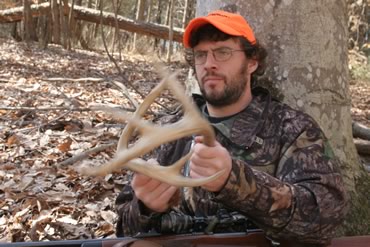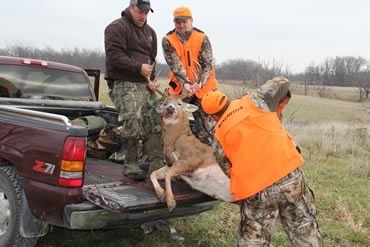Change your routine to see more bucks.
At 4 p.m. on most weekdays in November, Joe Carpenter lays down his tool belt, walks away from the job site and drives to the farm he’s been hunting most of his life. He parks at the same gate, walks down the same logging road and climbs into the same wooden stand he built a decade ago.
Joe might stop for a soda and a snack on the way to the farm, but on most days, you can set your watch by his arrival. If the deer in his woods wore watches, they could set theirs, too.
At exactly 30 minutes after sunset, Joe lowers his rifle from his stand and makes his way back to his truck, grateful for another peaceful evening in the deer woods.
“Maybe tomorrow evening,” he thinks.
Joe isn’t a real person, of course, but he might as well be.
Deer hunters everywhere are as predictable as the rising and setting sun. They hunt the same stands day in and day out, using the same trails to access them.
And just as Joe fails to see deer in the woods that are filled with rubs, droppings, scrapes and tracks, lots of other hunters shuffle back to their trucks at dark, empty-handed and confused.
The deer, however, know exactly what’s going on. After either seeing or smelling a human day after day, season after season from the same trail or tree, they’ve become conditioned to avoid certain areas at certain times of the day.
That’s exactly why your woods might be filled with fresh sign, but the deer are nowhere to be seen. They’ve got your number and know when it’s safe to prance past your treestand and when it’s not.
Pressure Down
Back when he was a college student, Virginia outfitter Chris McClellan was no different than Joe.
“I hunted the same farm every day of the season and often from the same treestand,” he says. “Looking back, I understand why I hardly saw any deer after the first few days of the season. I overhunted that spot.”
Deer can’t reason, and they don’t have the ability to calculate when you will be in the woods and when you won’t. But seeing or smelling a human multiple times can condition them to avoid walking through woods during daylight hours.
That’s why McClellan rarely puts a hunter in a specific stand more than a day at a time. Because his livelihood depends on hunter success, McClellan rotates his hunters around the 50 or so stands located on the 3,000-acre farm he hunts.
He might shift locations by as little as a hundred yards, or he might move a hunter to a completely different end of the farm. Whatever the distance, the purpose is the same: to avoid putting too much pressure on a single spot.
McClellan doesn’t have a specific stand rotation or any other system. He wants to keep the deer guessing and simply follows his intuition.
“I consider the wind, of course, but I take into account how long it’s been since a stand has been hunted and whether or not someone has seen a shooter buck from it,” he said.
Even if there’s a big buck in the neighborhood, McClellan limits the use of individual stands. He’ll occasionally hunt a setup two consecutive days, three at the very most, but that’s usually only for a morning or afternoon per day.
Sometimes a hunter will request a few extra sessions or an all-day sit in a particular stand, and McClellan honors such requests, but he’ll stay out of the area for a week or more afterward.
 REST IT
REST IT
Most hunters don’t have access to thousands of acres, nor the luxury of choosing from dozens of stands. They do, however, have the option of staying out of the woods for a few days.
As hard as it might be, limiting your presence is one of the best ways to keep deer from avoiding your stands.
Numerous studies have shown that bucks circle around stands once they’ve figured out where they are. They also go nocturnal when hunting pressure is high.
Whitetails are far more at ease and willing to move during daylight hours in areas with limited hunting pressure. It can be tough to stay out of the woods for several days at a time, but consider the alternative: spending lots of time in the same stands and never seeing a deer.
As McClellan says, there is no rule on how much time to let a block of timber rest, but one thing’s for sure: The longer it sits without being hunted, the more natural deer movement will be.
ROTATE IT
If your season is short and/or hunting time is limited and you just have to keep hunting, move to another stand.
Rotating stands can work in small blocks of cover, too. If you’re hunting a 10-acre patch of cover, try moving to the opposite end. Sometimes, that’s enough.
Even better, rotate days as well as stands. Consider a random schedule that puts you in one of two or three stands on different days. Add a day or two of rest between hunts, and you’ve got a season’s worth of fresh woods.
For example, hunt one stand for a half-day, wait a day and then switch to the second one for a morning or evening. Give the woods a little more rest and then rotate back to the first stand. Pressure on neighboring land can push deer onto yours. If there’s less pressure where you hunt, there’s a good chance the deer will stay there.
 CHANGE EVERYTHING
CHANGE EVERYTHING
Just switching locations isn’t enough to keep deer comfortable, however.
Instead of walking down the same path every time, try to approach your treestands from a different direction.
McClellan does that whenever possible, and he avoids walking across open fields in the mornings. He says it’s better to walk through the woods adjacent to a field. That can prevent whitetails feeding in fields from seeing you, offering at least a chance at getting a shot as they drift back to their bedding area.
He chooses his entry and exit paths based on the location of feeding and bedding areas. Sometimes, bumping deer is inevitable.
“If I bump deer from a stand of oaks as I’m walking in or out, I’ll let that spot rest for four or five days, maybe even more,” McClellan says.
Running a deer from under a stand once might not be the end of that spot, but two or three times? You might not have killed your chances of tagging a doe or a yearling buck, but the odds of seeing a mature buck are slim. Older bucks just don’t tolerate human interference in their living rooms.
THE LITTLE THINGS COUNT
It’s not just how and when you walk to your stand or how often you use it, either. Whitetails become accustomed to the sights, sounds and smells of their home turf.
Using the same set of rattling antlers and the same grunt tube day after day can have the same effect as sitting in the same stand repeatedly.
Even if you never saw a deer while you were rattling and grunting, a buck might have smelled you as he circled downwind. He also might have caught a whiff of human scent mixed with doe-in-heat lure. Once he associates that specific sound or smell with danger, he’s far more likely to avoid the area.
Are deer smart enough to tell the difference between two sets of antlers or two grunt tubes? McClellan thinks so. He also guides turkey hunters, and when he’s been chasing the same gobbler for more than a day, he switches calls.
“There’s no question a gobbler knows the sound of a specific hen or call that imitates a hen,” he said. “If he busts me or one of my hunters, then I’m definitely going to change calls the next time I’m in that area. I have no doubt a buck can tell the difference, as well.”
Whether or not a deer can distinguish two grunt tubes or two bottles of doe pee is certainly open for debate, but there’s no question they can figure out when you’re in the woods. Just ask Joe Carpenter. If he only made a few adjustments to his routine, maybe Joe would see a few more deer.
Read Recent Articles:
• Expletives Deleted: Here’s why leaving your bow in the clouds is not a good idea.
• A Place for Crossbows: Horizontal bows make great tools for recruiting and keeping hunters.
• Going Solo: Hunting with friends is great, but there are benefits to going alone.
This article was published in the October 2012 edition of Buckmasters Whitetail Magazine. Subscribe today to have Buckmasters delivered to your home.